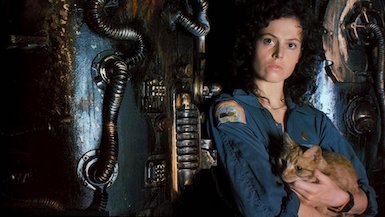The Number One Movie in America: Alien
By Sean Collier
August 23, 2020
Ridley Scott’s immortal “Alien” was a big hit.
Not as big as you might think, though.
The box-office pull from its opening run in 1979 landed somewhere in the neighborhood of $80 million, enough to land it in fifth place on the year-end charts. While it managed to edge out another highly influential journey into darkness, “Apocalypse Now,” it finished more than $20 million behind “Kramer vs. Kramer,” the year’s champion. “Rocky II” made more money; so did the first “Star Trek” movie.
“Alien” wasn’t even the top-grossing horror film of 1979. That distinction belongs to the much less effective “Amityville Horror,” the year’s second-place finisher and an $86 million earner.
Adjusted for inflation, “Alien” made about $275 million in 2020 dollars — a decided hit, but nothing to rave about.
Where the film was unmatched, however, was hype.
The film opened on only 91 North American screens — a low total, even before the days of super-wide releases. Despite what would today be called a very limited release, it won its opening weekend, pulling in more than $3.5 million, with a per-screen average of $38,767. Variety speculated that, at that point, it was the highest average in history.
Among those 91 screens, 51 reported all-time weekend attendance records. When it opened in London, at the Odeon Leicester Square, it pulled in more than $126,000 in four days, also a house record.
Underestimating demand, Fox had created only 148 prints of the film for its first month. That didn’t stop it from earning $16.5 million in that time period; each physical copy of “Alien,” in other words, was worth more than $100,000 in returns.
So yes: The hype was high.
Why couldn’t “Alien” ride that wave to all-time box office numbers? An R rating, even in the more permissive ’70s, didn’t help. Nor did a picture that is not exactly accessible to a casual audience; “Alien” is usually either cautiously slow or brutal, alternating between drawn-out scenes of escalating suspense and graphic horror action that can still shock today.
It’ll sell out in London, but it may be a bit too extreme for Peoria.
Enough digital ink has been spilled on the film’s endless merits and achievements, so I’ll only add this: For a film that’s usually regarded as science fiction rather than horror, its influence on the genre is undeniable. The ’70s had a number of horror hits, but most were either religiously tinged — Satan was big at the time — or ghost tales, like the aforementioned “Amityville.” Between 1978 and ’80, the blueprint for the future of the genre was, in my eyes, set by three films: “Halloween,” “The Shining” and “Alien.” Going forward, horror was not going to have a lonely spirit or lowly demon behind it; it would be cold, unfeeling, psychologically destructive and unstoppable.
That’s the terror in “Alien” — not that the beast is inherently frightening, but that it is powerful, merciless and inescapable. It’s Michael Myers, reconstituted as a hulking bondage beast; the Nostromo is the Overlook Hotel with even less hope of rescue.
That’s a much longer essay. Anyway.
The “Alien” franchise has gone in far too many directions since the original film burst forth onto the public 41 years ago. But the original film remains a miracle: A frozen puzzle box of bare horror. It’s unforgettable.
“Alien” is the subject of the latest episode of The Number One Movie in America, a look back at past box-office champions. Each episode’s film is drawn at random from a list of every number-one movie since 1982. Please listen and subscribe!
Next time: Heroes in a half-shell. Not those ones. Not those ones, either.




